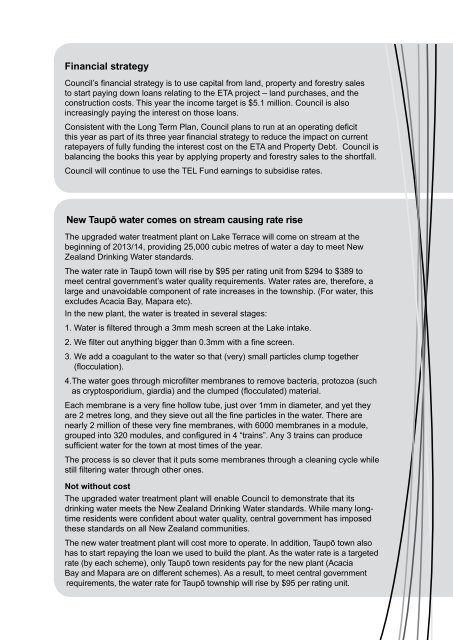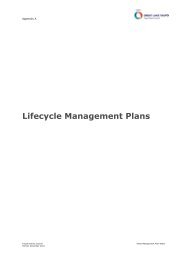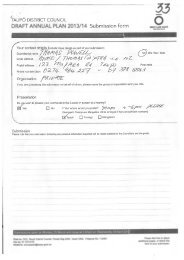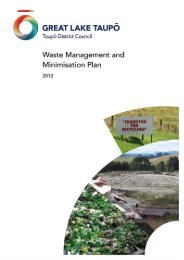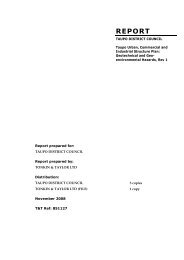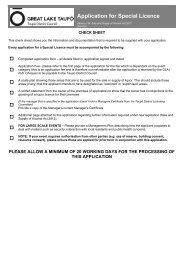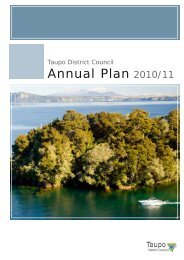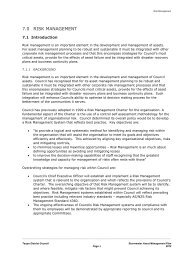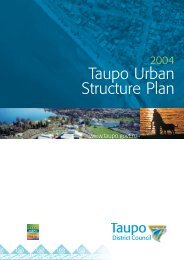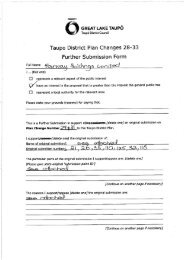Draft Annual Plan 2013/14 (10Mb PDF) - Taupo District Council
Draft Annual Plan 2013/14 (10Mb PDF) - Taupo District Council
Draft Annual Plan 2013/14 (10Mb PDF) - Taupo District Council
Create successful ePaper yourself
Turn your PDF publications into a flip-book with our unique Google optimized e-Paper software.
Financial strategy<br />
<strong>Council</strong>’s financial strategy is to use capital from land, property and forestry sales<br />
to start paying down loans relating to the ETA project – land purchases, and the<br />
construction costs. This year the income target is $5.1 million. <strong>Council</strong> is also<br />
increasingly paying the interest on those loans.<br />
Consistent with the Long Term <strong>Plan</strong>, <strong>Council</strong> plans to run at an operating deficit<br />
this year as part of its three year financial strategy to reduce the impact on current<br />
ratepayers of fully funding the interest cost on the ETA and Property Debt. <strong>Council</strong> is<br />
balancing the books this year by applying property and forestry sales to the shortfall.<br />
<strong>Council</strong> will continue to use the TEL Fund earnings to subsidise rates.<br />
New Taupō water comes on stream causing rate rise<br />
The upgraded water treatment plant on Lake Terrace will come on stream at the<br />
beginning of <strong>2013</strong>/<strong>14</strong>, providing 25,000 cubic metres of water a day to meet New<br />
Zealand Drinking Water standards.<br />
The water rate in Taupō town will rise by $95 per rating unit from $294 to $389 to<br />
meet central government’s water quality requirements. Water rates are, therefore, a<br />
large and unavoidable component of rate increases in the township. (For water, this<br />
excludes Acacia Bay, Mapara etc).<br />
In the new plant, the water is treated in several stages:<br />
1. Water is filtered through a 3mm mesh screen at the Lake intake.<br />
2. We filter out anything bigger than 0.3mm with a fine screen.<br />
3. We add a coagulant to the water so that (very) small particles clump together<br />
(flocculation).<br />
4.The water goes through microfilter membranes to remove bacteria, protozoa (such<br />
as cryptosporidium, giardia) and the clumped (flocculated) material.<br />
Each membrane is a very fine hollow tube, just over 1mm in diameter, and yet they<br />
are 2 metres long, and they sieve out all the fine particles in the water. There are<br />
nearly 2 million of these very fine membranes, with 6000 membranes in a module,<br />
grouped into 320 modules, and configured in 4 “trains”. Any 3 trains can produce<br />
sufficient water for the town at most times of the year.<br />
The process is so clever that it puts some membranes through a cleaning cycle while<br />
still filtering water through other ones.<br />
Not without cost<br />
The upgraded water treatment plant will enable <strong>Council</strong> to demonstrate that its<br />
drinking water meets the New Zealand Drinking Water standards. While many longtime<br />
residents were confident about water quality, central government has imposed<br />
these standards on all New Zealand communities.<br />
The new water treatment plant will cost more to operate. In addition, Taupō town also<br />
has to start repaying the loan we used to build the plant. As the water rate is a targeted<br />
rate (by each scheme), only Taupō town residents pay for the new plant (Acacia<br />
Bay and Mapara are on different schemes). As a result, to meet central government<br />
requirements, the water rate for Taupō township will rise by $95 per rating unit.


